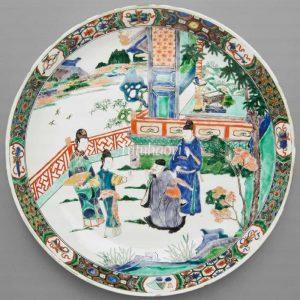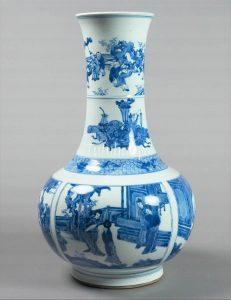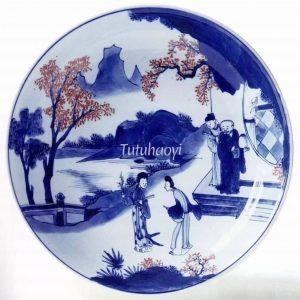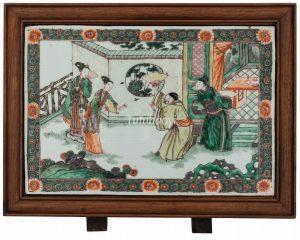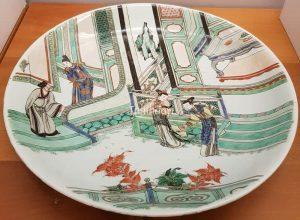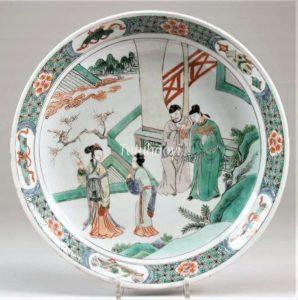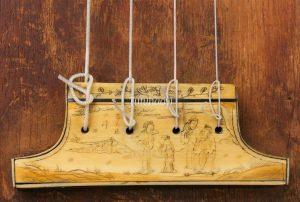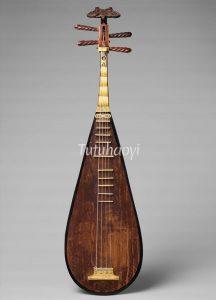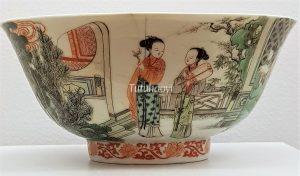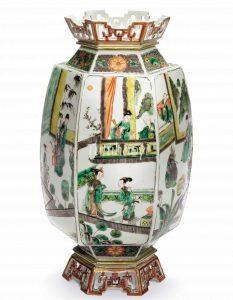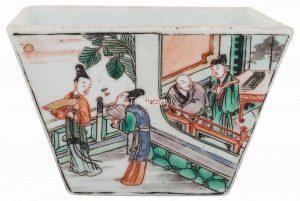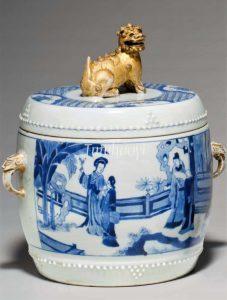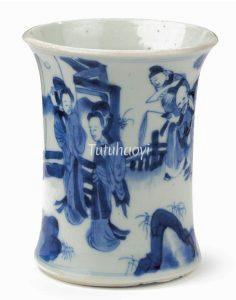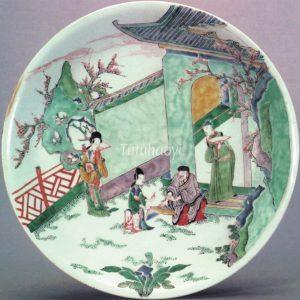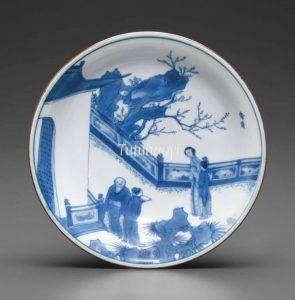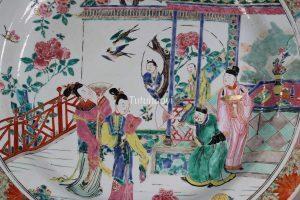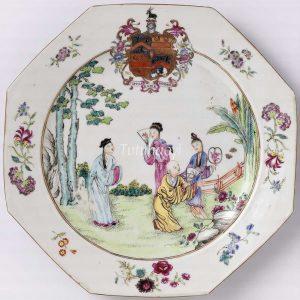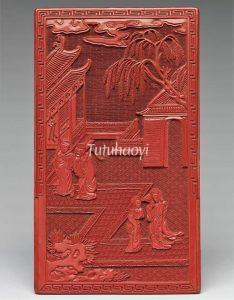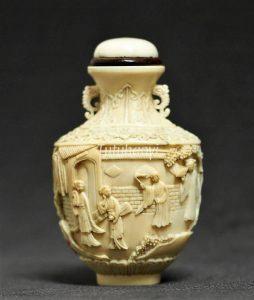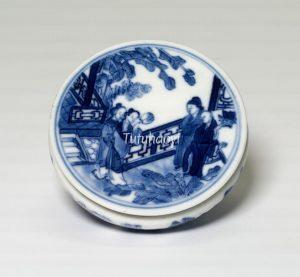Scholar Zhang and Cui Yingying’s encounter in the Salvation Monastery
佛殿奇逢 (惊艳)
© Tutuhaoyi.com owns the copyright of the description content for the images attached. Quoting all or part of the description content on this page is permitted ONLY IF ‘Tutuhaoyi.com’ is clearly acknowledged anywhere your quote is produced unless stated otherwise. (本页描述内容版权归Tutuhaoyi.com所有,转发或引用需注明 “Tutuhaoyi.com”, 侵权必究, 已注开源信息的条目除外。)
This scene is from one of the most famous Chinese dramatic works, Romance of the Western Chamber 西厢记, which was written by the Yuan playwright Wang Shifu (王实甫 1260–1336). The play tells the story of a secret love affair between Zhang Gong (张珙, also called Scholar Zhang 张生) and Cui Yingying 崔莺莺, the daughter of former Prime Minister Cui of the Tang court. The lovers are aided by a clever maid, Hong Niang 红娘, who helps them overcome daunting obstacles such as an imperious mother, a prior betrothal, and an attempted abduction by a cruel bandit.
This scene is from Scene One in Act One, which describes the first encounter of the lovers in a temple. Zhang is going to the capital to attend the highest civil service examinations. On the way he pays a visit to the nearby Salvation Monastery. In the monastery, a monk named Fa Cong 法聪 shows him around. Zhang meets Cui and her maid in front of the Buddha hall. Startled by Cui’s beauty, Zhang can’t keep his eyes off her. However, seeing a male stranger nearby, Hong Niang advises her lady Yingying to leave immediately.
image identification and story scene description by Dr Yibin Ni
More discussion on Scholar Zhang’s gaze at Yingying is available in this blog here.
Other episodes in the Romance of the Western Chamber:
Scholar Zhang embarking on his journey to sit for civil-service examinations 张生赶考
Consummation of love from Western Chamber 月下佳期
Yingying listening to the qin zither playing 莺莺听琴
Yingying receiving good news delivered by the pageboy 泥金报捷
Scholar Zhang getting drunk due to Madame Cui’s broken promise 张生醉酒 (崔母悔婚)
Fig 1: porcelain dish with underglaze blue decoration, Kangxi period (1662–1722), Qing dynasty, courtesy of Museum of East Asian Art, Cologne, Germany
Fig 2: porcelain dish with overglaze enamelled decoration, Kangxi period (1662–1722), Qing dynasty, courtesy of Philadelphia Museum of Art
Fig 3: porcelain vase with underglaze blue decoration, Kangxi period (1662–1722), Qing dynasty, courtesy of the Metropolitan Museum of Art, New York
Fig 4: porcelain plate with overglaze enamelled decoration, Kangxi period (1662–1722), Qing dynasty, courtesy of Princessehof Ceramics Museum, Leeuwarden, The Netherlands
Fig 5: porcelain screen with overglaze enamelled decoration, Kangxi period (1662–1722), Qing dynasty, courtesy of National Gallery of Victoria, Melbourne, Bequest of Leonard B. Cox, 1976. Photo: National Gallery of Victoria, Melbourne
Fig 6: porcelain dish with underglaze blue and copper red decoration, Kangxi period (1662–1722), Qing dynasty, courtesy of Sir Michael Butler Collection
Fig 7: porcelain plaque with overglaze enamelled decoration, Kangxi period (1662–1722), Qing dynasty, courtesy of Jie Rui Tang Collection
Fig 8: porcelain dish with overglaze enamelled decoration, Kangxi period (1662–1722), Qing dynasty, courtesy of The Guimet Museum, Paris. Photo: Raid Kneife
Fig 9: porcelain dish with overglaze enamelled decoration, Kangxi period (1662–1722), Qing dynasty, courtesy of Princessehof Ceramics Museum, Leeuwarden, The Netherlands
Fig 10-11: wooden pipa with ivory string holder, late 16th – early 17th century, courtesy of the Metropolitan Museum of Art, New York
Fig 12: porcelain dish with overglaze enamelled decoration, Kangxi period (1662–1722), Qing dynasty, courtesy of The Guimet Museum, Paris. Photo: Raid Kneife
Fig 13: famille verte hexagonal lantern, Kangxi period (1662–1722), Qing dynasty, courtesy of Christie’s Auction House, 15 Sep 2016, Lot 903
Fig 14: porcelain bowl with underglaze blue decoration, Kangxi period (1662–1722), Qing dynasty, courtesy of Bertrand de Lavergne collection
Fig 15: porcelain bowl with overglaze enamelled decoration, Kangxi period (1662–1722), Qing dynasty, courtesy of Jie Rui Tang Collection
Fig 16: drum-shaped jar with underglaze blue decoration, Kangxi period (1662–1722), Qing dynasty, courtesy of Sotheby’s Auction House, New York, 23 March 2022, No 333
Fig 17: famille verte bitong brush holder, Kangxi period (1662–1722), Qing dynasty, courtesy of Bonhams Auction House, London, 8 Nov 2018
Fig 18: brush pot with underglaze blue decoration, Kangxi period (1662–1722), Qing dynasty, courtesy of Christie’s Auction House, 27 Mar 2013, Lot 281
Fig 19: porcelain dish with overglaze enamelled decoration, Kangxi period (1662–1722), Qing dynasty, courtesy of Sir Michael Butler Collection
Fig 20-21: gu-form beaker vase with underglaze blue decoration, circa 1640–60, courtesy of Freeman’s Auction House, April 8, 2021, Lot 8
Fig 22: shallow porcelain bowl with underglaze blue decoration, Shunzhi period (1644–61), Qing dynasty, courtesy of Christie’s Auction House, 16 Mar 2015, ‘An era of inspiration: 17th-century Chinese porcelains from the collection of Julia and John Curtis’, lot 3561
Fig 23-24: famille verte beaker vase, c.1640-1670, courtesy of Christie’s Auction House, 29 Mar 2006, Lot 478
Fig 25-26: famille rose porcelain dish, Yongzheng period (1723–35), Qing dynasty, courtesy of Guest & Gray Antique Dealer, London
Fig 27: porcelain plate with overglaze enamelled decoration, c.1740–1760, courtesy of the Rijksmuseum, Amsterdam
Fig 28: small table screen of lacquer or ivory, 18th–19th century, courtesy of the Metropolitan Museum of Art, New York
Fig 29: carved ivory snuff bottle, 18th–19th century, courtesy of the Trustees of the British Museum
Fig 30: circular porcelain box with underglaze blue decoration, Qing dynasty (1644–1911), courtesy of the Art Institute of Chicago
Fig 31: details from the Romance of the Western Chamber by Dong Jieyuan, a woodblock printing edition published in Ming dynasty (1368–1644) by Yang Shen and Huang Jiahui

